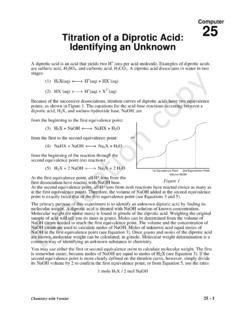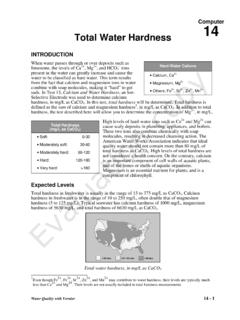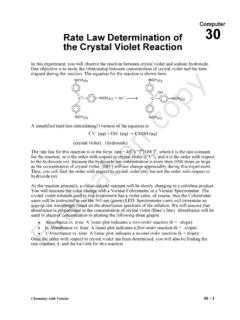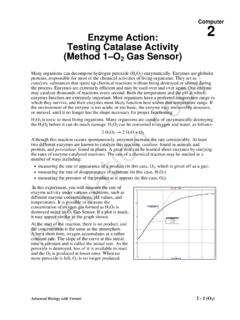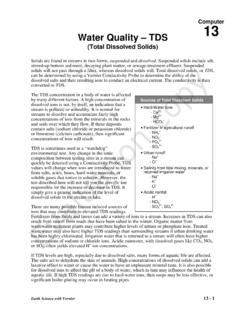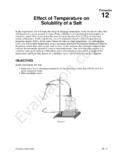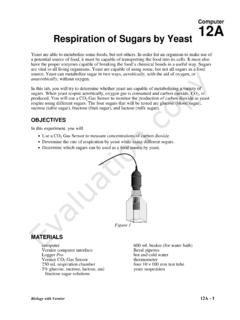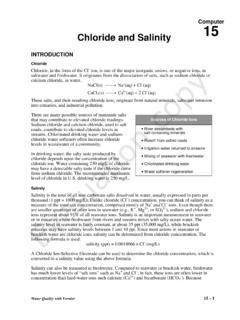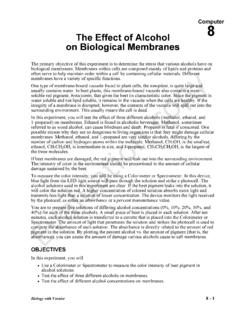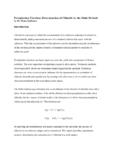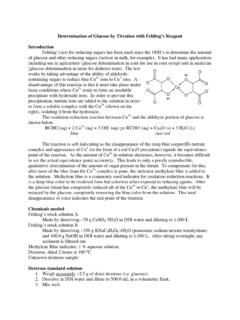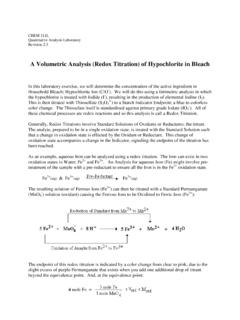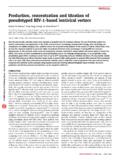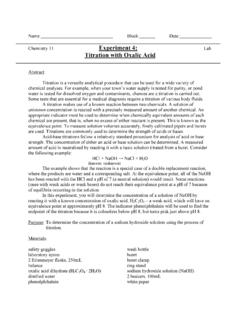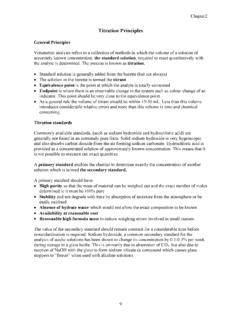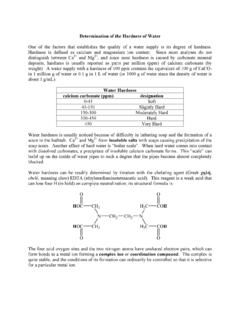Transcription of 7 Acid-Base Titration Computer
1 Computer 7 Advanced Chemistry with Vernier 7 - 1 Acid-Base Titration A Titration is a process used to determine the volume of a solution that is needed to react with a given amount of another substance. In this experiment, your goal is to determine the molar concentration of two acid solutions by conducting titrations with a base of known concentration. You will be testing a strong acid , HCl, solution and a weak acid , HC2H3O2, solution. You will use the sodium hydroxide, NaOH, solution that you standardized in Lab 6 as your base of known concentration. The reaction equations are shown below in net ionic form. H+ (aq) + OH (aq) H2O(l) HC2H3O2(aq) + OH (aq) H2O(l) + C2H3O2 (aq) The stoichiometry of the two reactions is identical; thus, your calculations will be straightforward. However, you will observe a significant difference in how the two acid solutions react with NaOH.
2 In this experiment, you will use a Computer to monitor pH as you titrate. The region of most rapid pH change will then be used to determine the equivalence point. The volume of NaOH titrant used at the equivalence point will be used to determine the molarity of the HCl solution. OBJECTIVES In this experiment, you will Accurately conduct Acid-Base titrations . Determine the equivalence point of a strong acid -strong base Titration . Determine the equivalence point of a weak acid -strong base Titration . Calculate the molar concentrations of two acid solutions. Figure 1 Evaluation copyComputer 7 7 - 2 Advanced Chemistry with Vernier CHOOSING A METHOD If you choose Method 1, you will conduct the Titration in a conventional manner. You will deliver volumes of NaOH titrant from a buret. You will enter the buret readings manually to store and graph each pH-volume data pair.
3 If you choose Method 2, you will use a Vernier Drop Counter to conduct the Titration . NaOH titrant is delivered drop by drop from the reagent reservoir through the Drop Counter slot. After the drop reacts with the reagent in the beaker, the volume of the drop is calculated and a pH-volume data pair is stored. MATERIALS Materials for both Method 1 (buret) and Method 2 (Drop Counter) Vernier Computer interface wash bottle Computer distilled water Vernier pH Sensor ring stand M sodium hydroxide, NaOH solution utility clamp hydrochloric acid , HCl, solution, unknown molarity 250 mL beaker acetic acid , CH3 COOH, solution, unknown molarity 10 mL pipet with pump magnetic stirrer 50 mL graduated cylinder stirring bar or Microstirrer Materials required only for Method 1 (buret) 50 mL buret buret clamp 10 mL pipet Materials required only for Method 2 (Drop Counter)
4 Vernier Drop Counter 100 mL beaker 60 mL reagent reservoir 10 mL graduated cylinder 5 mL pipet or graduated 10 mL pipet a second 250 mL beaker METHOD 1: Measuring Volume Using a Buret 1. Obtain and wear goggles. 2. Obtain about 25 mL of a hydrochloric acid solution of unknown concentration. Add 50 mL of distilled water to a 250 mL beaker. Use a pipet bulb (or pipet pump) to transfer 10 mL of the HCl solution into the beaker. CAUTION: Handle the hydrochloric acid with care. It can cause painful burns if it comes in contact with the skin. 3. Place the beaker on a magnetic stirrer and add a stirring bar. If no magnetic stirrer is available, stir the reaction mixture with a stirring rod during the Titration . 4. Connect a pH Sensor to Channel 1 of a Vernier Computer interface. Connect the interface to the Computer using the proper cable. 5. Set up a ring stand, buret clamp, and mL buret to conduct the Titration (see Figure 1).
5 Rinse and fill the buret with M NaOH solution. Note: Record the precise concentration of the NaOH solution in your data table. CAUTION: Sodium hydroxide solution is caustic. Avoid spilling it on your skin or clothing. Acid-Base Titration Advanced Chemistry with Vernier 7 - 3 6. Use a utility clamp to suspend the pH Sensor on the ring stand, as shown in Figure 1. Position the pH Sensor so that its tip is immersed in the HCl solution but is not struck by the stirring bar. Gently stir the beaker of acid solution. 7. Run the Logger Pro program on your Computer . Open the file 07a Acid-Base from the Advanced Chemistry with Vernier folder. 8. You are now ready to begin the Titration . a. Before adding NaOH titrant, click . Once the displayed pH reading has stabilized, click . In the edit box, type 0 (for 0 mL added). Press the ENTER key to store the first data pair for this experiment.
6 B. Add the next increment of NaOH (enough to raise the pH about units). When the pH stabilizes, again click . In the edit box, type the current buret reading as accurately as possible. Press ENTER. You have now saved the second data pair for the experiment. c. Continue adding NaOH solution in increments that raise the pH by about units and enter the buret reading after each increment. When a pH value of approximately is reached, change to a one-drop increment. d. After a pH value of approximately 10 is reached, add larger increments that raise the pH by about pH units, and enter the buret level after each increment. e. Continue adding NaOH solution until the pH value remains constant. 9. When you have finished collecting data, click . Dispose of the reaction mixture as directed. Rinse the pH Sensor with distilled water in preparation for the second Titration .
7 10. Follow the steps below to find the equivalence point, which is the largest increase in pH upon the addition of a very small amount of NaOH solution. A good method of determining the precise equivalence point of the Titration is to take the second derivative of the pH-volume data, a plot of 2pH/ vol2. a. View a plot of the second derivative on Page 3 by clicking the Next Page button, . b. Analyze the second derivative plot and record the volume of NaOH at the equivalence point. 11. Go back to the original Titration graph. Print a copy of the graph and the data set. Conduct a second trial if directed by your instructor. If you wish to save the results of the Titration (s), choose Store Latest Run from the Experiment menu. 12. Repeat the necessary steps to test the acetic acid solution. Conduct a second trail of the acetic acid solution if directed by your instructor.
8 Analyze, print, and save the Titration data for your acetic acid solution trial(s). METHOD 2: Measuring Volume with a Drop Counter 1. Obtain and wear goggles. 2. Add 40 mL of distilled water to a 100 mL beaker. (You can add less, about 20 mL, if you will be using a stirring bar instead of the Microstirrer.) Use a pipet bulb (or pipet pump) to pipet mL of the HCl solution into the 100 mL beaker with distilled water. CAUTION: Handle the hydrochloric acid with care. It can cause painful burns if it comes in contact with the skin. Computer 7 7 - 4 Advanced Chemistry with Vernier Figure 2 3. Lower the Drop Counter plate onto a ring stand and clamp it into position (see Figure 2). 4. Connect the Drop Counter to DIG/SONIC 1 of the Vernier Computer interface. Connect the pH Sensor to CH 1 of the Computer interface. 5. Run the Logger Pro program on your Computer .
9 Open the file 07b Acid-Base (Drop) from the Advanced Chemistry with Computers folder. 6. Obtain the plastic 60 mL reagent reservoir. Close both valves by turning the handles to a horizontal position. Follow the steps below to set up the reagent reservoir for the Titration . a. Rinse the reagent reservoir with a few mL of the M NaOH solution and pour the rinse NaOH into an empty 250 mL beaker. b. Use a utility clamp to attach the reservoir to the ring stand. c. Fill the reagent reservoir with slightly more than 60 mL of the M NaOH solution. Note: Record the precise concentration of the NaOH solution in your data table. d. Place the 250 mL beaker, which contains the rinse NaOH, beneath the tip of the reservoir. e. Drain a small amount of the NaOH solution into the 250 mL beaker so that it fills the reservoir s tip. To do this, turn both valve handles to the vertical position for a moment, then turn them both back to horizontal.
10 F. Discard the drained NaOH solution in the 250 mL beaker as directed. 7. Calibrate the drops that will be delivered from the reagent reservoir. Note: If you are using the stored calibration (28 drops per mL), then skip this step. a. On the top row of the LoggerPro toolbar, open the Experiment menu and choose Calibrate ` DIG 1: Drop Counter. b. Proceed by one of these two methods: If you have previously calibrated the drop size of your reagent reservoir and want to continue with the same drop size, select the Manual button, enter the number of Drops / mL, and click . Then proceed directly to Step 8. If you want to perform a new calibration, select the Automatic button, and continue with this step. Acid-Base Titration Advanced Chemistry with Vernier 7 - 5 c. Place a 10 mL graduated cylinder directly below the slot on the Drop Counter, lining it up with the tip of the reagent reservoir.
